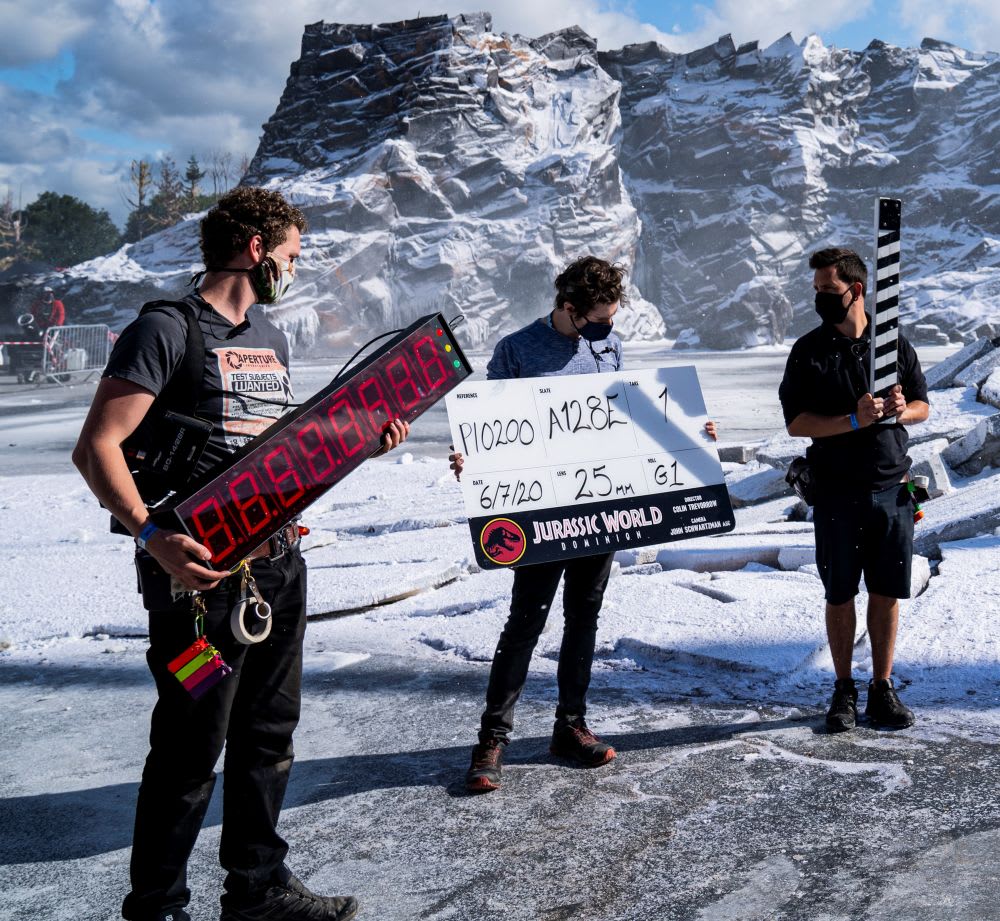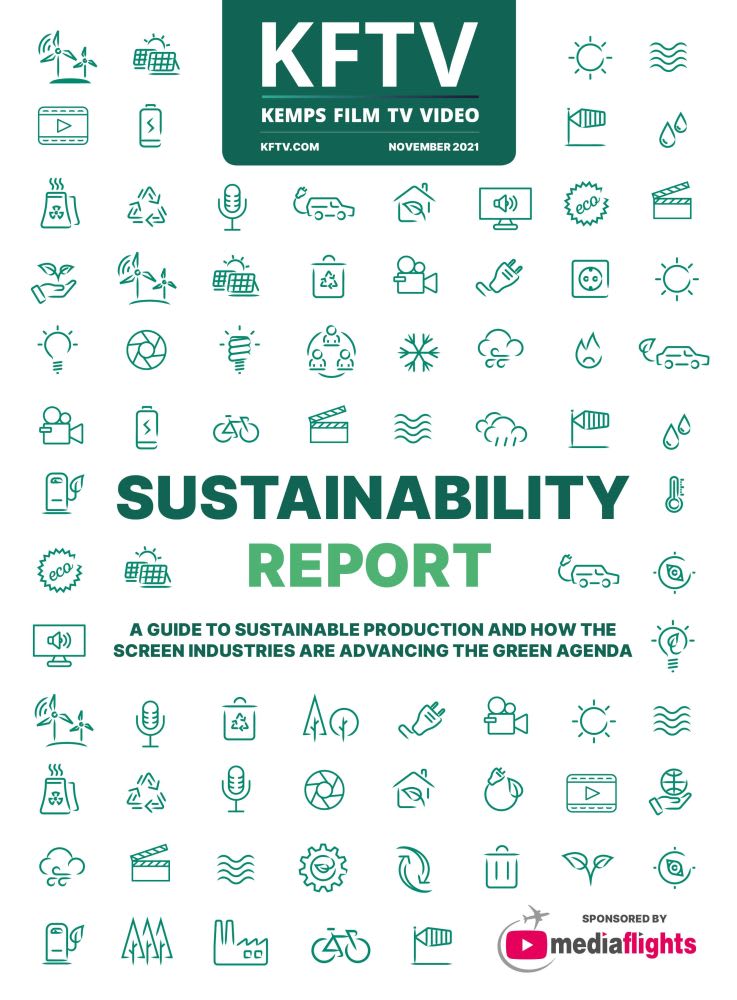Case Study - Jurassic World: Dominion
Louise Marie Smith, sustainability manager on the film, tells Chris Evans about how a green agenda was embedded into the complex production process
By Chris Evans 29 Oct 2021

From re-usable dinosaurs and stunt wires to beef-free catering, Louise Marie Smith, sustainability manager on Jurassic World: Dominion, talks to Chris Evans about how a green agenda was embedded into the complex production process
For the third instalment in the Jurassic World series, Universal Pictures and Amblin Entertainment have taken dinosaur-sized steps to tackle sustainability on set. So much so that even the creatures themselves are made from renewable material.
“They are created with silicone and fibreglass moulds that, once finished with, can be sent to a company called Green Clover who melt them down for re-use. Previously these materials were not recyclable,” explains Jurassic World: Dominion sustainability manager Louise Marie Smith, who was brought onboard the project early as a consultant through her company Neptune Environmental Solutions, having worked with Universal on previous projects (see sidebar, overleaf).
Preparing the sustainability agenda is key, both to Smith and the studios, and that certainly proved the case for this $165m project, which ended up taking 18 months to shoot, predominantly at the UK’s Pinewood Studios.
In pre-production, a meticulous environmental accounting report tracked all flight, hotel and accommodation bookings, fuel used for ground transportation, and hire of boats and helicopters for filming. Everything that created a carbon emission was tagged through the account system and fed into a carbon calculator. “We could see what percentage of our CO2 was from fuel, accommodation etc,” says Smith. She also worked with the production, construction and location teams to recommend and oversee which service providers and supply chain companies were used, and ensure they were environmentally friendly.
“I checked those providing camera equipment, rental cars, trucks, skips, timber, water coolers etc to make sure they could provide electric vehicles, recyclable or re-usable materials, and in the case of timber were FSC (Forest Stewardship Council) assured,” she explains.
Pivot for Covid
Then disaster struck in spring last year with the arrival of the global pandemic, putting an end to the dinosaurs once more, if only for a few months.
Post UK lockdown in July last year, the team was keen to return to work and indeed Jurassic World: Dominion was the first major studio production to start shooting again. But it was a very different environment to the one pre-Covid.
“It was a worrying time for everyone, so we had to tread carefully, especially as people had to get used to wearing masks and being in groups again,” says Smith. “Fortunately, both the studio and production office were keen to still push the sustainability agenda.”
This meant handling PPE in a sustainable way, including re-usable masks that crew could wash and wear, reducing the number of disposable ones on set. “We also encouraged them to bring in their own bottles to refill, which meant speaking to the suppliers to get hold of touch-free [water coolers],” adds Smith, who worked closely with the Covid team.

Jurassic World: Dominion was the first major studio production to start shooting after lockdown. Credit: John Wilson/Universal Pictures
On the catering side, each meal and items of cutlery had to be individually packaged, and food tables and platters were cut out. For sustainability reasons, beef was eliminated from the menu.
“We worked with the catering team so that everything was compostable and used a company to manage the waste properly,” says Smith. “For any edible food left over, we had freezers and a blast chiller so we could freeze it and then send it to [surplus food redistribution charity] City Harvest to be distributed across London. The non-edible food was sent to a company for anaerobic digestion, where they break it down in a big vat and all the gases like methane that come out are used to produce electricity. The sludge left over is then used as fertiliser on farmland.”
There was also a considerable shift to a ‘digital office’, which meant no unnecessary printing. “Previously we were already moving to digital for the PO [purchase order] systems, staff paperwork and time sheets, but now it was for a lot more, including invoice sign-offs through [cloud-based digital transaction platform] DocuSign, which was actually easier to implement in the pandemic because it meant less human contact and will now likely stay.”
Non Covid-related sustainability initiatives — such as the recyclable dinosaurs — continued to be introduced. Filming at Pinewood helped on this front as the studio runs on renewable energy. “We used grid power for the offices, workshops and stages, and even had power drops in the backlot we could plug into, so didn’t need to use generators in those spaces,” adds Smith.
“Then for the remote location shoots where we were running a unit base out of a field with no power, we would bring in generators run on renewable diesel [fuel made from renewable feedstocks that has approximately 70% less lifecycle carbon emissions than standard diesel].”
Smith concedes it is not a perfect solution, but certainly practical, and better than alternatives if power needs to be generated remotely. Even changes such as these have taken time to introduce because of the need to convince kit hire companies to agree to use renewable diesel.
“Sustainable changes can be slow to implement because the supply chain is long and the stakes are high on a film [and TV] set,” Smith explains. “People are cautious about risk because it can impact insurance.”
Waste management
Once a shoot is completed, further issues around the carbon footprint arise during the clear up. For Jurassic World: Dominion, this meant dealing with huge sets and tons of equipment. The sets, while made from FSC timber, were often bonded with other materials (foams, paints, poly etc), which were more difficult to recycle.
The sets on blockbusters of this size are often so large they cannot be stored easily for future use. Plus, any recycling of sets must happen under a veil of secrecy that protects the film’s intellectual property (IP) ahead of release.
“This is always an issue, and will remain so at least in the short term,” concedes Smith. “But with the franchise films, there’s an effort to store pieces to re-use if they know there’ll be a sequel.
“Plus, the waste vendors that the construction team use have a [90%‑plus] diversion-from-landfill rate. We try to recycle wood and cardboard as many times as possible. And if they can’t recycle materials, they will put them through a waste-to-energy process, where they incinerate and use the energy produced for local housing.”
Another recycling initiative introduced on the stunt-heavy Jurassic World film was the disposal of the stunt wires and safety equipment after they had been used.
“We turned to a company called Extreme Rigging, based at Pinewood, who were able to take the wires [which cannot be used again for safety reasons] and send them back to the manufacturer in bulk to be broken down to the individual fibres and then recycled; previously they would just be dumped in the skip,” explains Smith. “It is about having conversations with the crew to let them know these options exist and facilitate the logistics of making it happen.”
Towards the end of productions, including on Jurassic World, Smith works with the production office and asset manager to assess everything that is left over — such as props, office equipment, drawing boards from the art department, fridges, toasters etc — and decides how to re-use it.
“The first base is to try and give it to the next production from the studio to use. Whatever’s left after that we give to a network of local charities. If it’s art supplies we will call up a design college, or lighting will go to a film school etc. So, we make sure there is as little waste as possible.”
Every sustainable decision on set is carefully considered and then measured to assess its impact, so that Smith can give feedback to the studio and establish what did and did not work.
“We learned a lot on Jurassic World: Dominion,” she concludes. “It was just such a pleasant surprise that everyone’s commitment to the production and sustainability stood fast through a challenging period.”
PROFILE: Louise Marie Smith
Smith has worked for more than 15 years as a consultant in environmental science and management, previously for government agencies, before making the switch to film and TV and setting up Neptune Environmental Solutions in 2007. She has since developed relationships with US studios and worked on high-profile features including Disney’s Into The Woods, MGM/Eon’s No Time To Die and — for Universal Pictures — Fast & Furious 9, Hobbs & Shaw, Last Christmas and Jurassic World: Dominion.
Contact: neptuneenvironmentalsolutions.com
t @Neptune_Enviro
This feature is part of our comprehensive Sustainability Report, which you can read below...
Latest news & features
Promote your services with KFTV
Choose from three profile types - Basic, Silver and Gold
Create ProfileWe offer a range of display advertising opportunities.
Learn More
